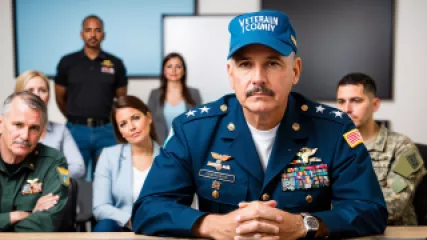The Ultimate Guide to Therapy for Veterans
The Ultimate Guide to Therapy for Veterans
As a veteran, navigating the complexities of mental health and finding the right support can be a daunting task. However, accessing therapy and psychological services can be a transformative step in your journey towards healing and wellness. In this comprehensive guide, we will explore the nuances of therapy for veterans, highlighting the benefits, various modalities, and practical steps to access the care you deserve.
Understanding the Unique Challenges Veterans Face
Veterans often face a unique set of challenges that can impact their mental health and well-being. From the physical and emotional toll of combat to the challenges of reintegrating into civilian life, veterans may experience a range of mental health concerns, including post-traumatic stress disorder (PTSD), depression, anxiety, and substance abuse. These issues can have a profound effect on their personal relationships, professional lives, and overall quality of life.
Recognizing the need for specialized care, the Department of Veterans Affairs (VA) and various community-based organizations have made significant strides in expanding access to mental health services for veterans. However, navigating the system and finding the right therapist or program can still be a daunting task. This guide aims to empower veterans and their loved ones by providing a comprehensive understanding of the available resources and the steps to access the support they need.
The Benefits of Therapy for Veterans
Engaging in therapy can offer a multitude of benefits for veterans, including:
- Improved mental health and well-being: Therapy can help veterans manage symptoms of PTSD, depression, anxiety, and other mental health concerns, leading to a better overall quality of life.
- Enhanced coping strategies: Therapists can teach veterans effective coping mechanisms and stress management techniques to navigate the challenges they face.
- Strengthened relationships: Therapy can help veterans improve their communication skills and deepen their connections with loved ones, fostering stronger personal and professional relationships.
- Increased self-awareness and personal growth: Through the therapeutic process, veterans can gain a deeper understanding of themselves, their experiences, and their path forward, leading to personal growth and empowerment.
- Reduced risk of substance abuse and addiction: Therapy can address the underlying issues that may contribute to substance abuse, providing veterans with healthier coping mechanisms and a pathway to recovery.
By acknowledging the unique challenges veterans face and the transformative benefits of therapy, we can empower this community to seek the support they deserve and take significant strides towards a healthier, more fulfilling life.
Different Modalities of Therapy for Veterans
When it comes to therapy for veterans, there is no one-size-fits-all approach. Instead, a range of therapeutic modalities are available, each catering to different needs and preferences. Let's explore some of the most common and effective therapies for veterans:
Individual Therapy
Individual therapy, often referred to as one-on-one counseling, provides a private and confidential space for veterans to work through their mental health concerns with a licensed therapist. This modality allows for a personalized approach, where the therapist can tailor the treatment plan to the veteran's unique experiences and goals.
Group Therapy
Group therapy can be a powerful tool for veterans, as it offers a supportive and understanding environment where they can connect with others who have shared similar experiences. In a group setting, veterans can learn from each other, practice communication skills, and find solidarity in their collective journey towards healing.
Family Therapy
The impact of a veteran's mental health challenges can extend to their family members, and family therapy can be instrumental in addressing these relational dynamics. By involving loved ones in the therapeutic process, veterans can improve communication, repair fractured relationships, and better understand the ways in which their experiences have affected their family.
Cognitive-Behavioral Therapy (CBT)
Cognitive-Behavioral Therapy (CBT) is a widely-recognized and evidence-based approach that focuses on identifying and modifying maladaptive thought patterns and behaviors. This therapy can be particularly effective for veterans struggling with PTSD, depression, and anxiety, as it helps them develop coping strategies and reframe their perspectives.
Trauma-Focused Therapies
Therapies that specifically address trauma, such as Eye Movement Desensitization and Reprocessing (EMDR) and Prolonged Exposure Therapy, can be highly beneficial for veterans who have experienced combat-related or other forms of trauma. These modalities aim to help veterans process and integrate their traumatic experiences, reducing the intensity of associated symptoms.
Holistic and Alternative Therapies
In addition to traditional talk therapies, some veterans may find solace in holistic and alternative therapies, such as mindfulness meditation, yoga, art therapy, and equine-assisted therapy. These approaches can complement conventional treatments by addressing the mind-body connection and promoting overall wellness.
The key is to explore the different modalities and work closely with a mental health professional to determine the best fit based on the veteran's unique needs, preferences, and goals. By embracing a diverse range of therapeutic options, veterans can find the support and tools they need to navigate their journey towards healing and well-being.
Accessing Therapy for Veterans
Accessing therapy and mental health services can be a daunting process, but it is crucial for veterans to take that first step. Here are some practical steps to help veterans and their loved ones navigate the system and connect with the care they need:
Utilize VA Mental Health Services
The Department of Veterans Affairs (VA) offers a wide range of mental health services, including individual and group therapy, psychiatric care, and specialized programs for PTSD, substance abuse, and other mental health concerns. Veterans can access these services by contacting their local VA medical center or community-based outpatient clinic.
Explore Community-Based Resources
In addition to the VA, there are numerous community-based organizations and non-profit groups that provide mental health services and support specifically for veterans. These resources can include veteran-focused counseling centers, support groups, and online therapy platforms. Researching these local and national options can help veterans find the right fit for their needs.
Seek Referrals and Recommendations
Asking for referrals from trusted healthcare providers, social workers, or fellow veterans can be a valuable way to identify qualified and experienced therapists. These personal recommendations can provide valuable insight into the therapist's approach and whether they specialize in working with the veteran population.
Utilize Insurance and Financial Assistance
Many private insurance plans, as well as Medicaid and Medicare, cover mental health services, including therapy. Veterans should check with their insurance provider to understand their coverage and any potential out-of-pocket costs. Additionally, some organizations and therapists offer sliding-scale fees or financial assistance programs to ensure that cost is not a barrier to accessing care.
Consider Telehealth Options
The COVID-19 pandemic has led to a significant expansion of telehealth services, allowing veterans to receive therapy and counseling remotely. This can be particularly beneficial for those who live in rural areas or have mobility challenges, as it provides greater access to mental health professionals without the need for in-person visits.
Remember, the path to accessing therapy may involve some trial and error, but persistence is key. Veterans should not hesitate to explore multiple options and providers until they find the right fit for their unique needs and preferences.
Overcoming Common Barriers to Therapy
While the benefits of therapy for veterans are well-documented, many still face significant barriers to accessing and engaging in mental health services. Understanding and addressing these obstacles can help veterans overcome their hesitations and take the first steps towards achieving better mental health and well-being.
Stigma and Misconceptions
Unfortunately, there is still a persistent stigma surrounding mental health, and many veterans may feel ashamed or reluctant to seek help. It is important to challenge these harmful misconceptions and emphasize that seeking therapy is a sign of strength, not weakness. Education and open conversations can help dispel the stigma and encourage veterans to prioritize their mental health.
Logistical Challenges
Practical barriers, such as transportation, childcare, and scheduling conflicts, can make it difficult for veterans to attend regular therapy sessions. Exploring options like telehealth, flexible scheduling, and supportive services can help mitigate these challenges and make therapy more accessible.
Trust and Rapport
Building trust and rapport with a therapist can be especially important for veterans, who may have experienced trauma or have difficulty opening up. Veterans should be encouraged to explore multiple providers until they find a clinician with whom they feel comfortable and understood.
Concerns about Confidentiality
Some veterans may be hesitant to seek therapy due to concerns about the confidentiality of their records and the potential impact on their careers or security clearances. It is crucial to educate veterans about the strict confidentiality policies that govern mental health services, as well as the legal protections in place to safeguard their privacy.
By addressing these common barriers and providing veterans with the resources and support they need, we can empower more individuals to take the crucial step of seeking therapy and, in turn, improve their overall well-being and quality of life.
The Role of Loved Ones and Community Support
The journey towards mental health and wellness is not one that veterans must undertake alone. The support and involvement of loved ones, as well as the broader community, can be instrumental in a veteran's recovery and resilience.
Supporting Loved Ones
Family members and close friends can play a vital role in encouraging veterans to seek therapy, providing emotional support, and helping them navigate the mental health system. By educating themselves about the unique challenges veterans face and learning effective communication strategies, loved ones can create a nurturing and understanding environment that fosters the veteran's progress.
Community-Based Initiatives
Beyond individual support, communities can come together to develop and promote initiatives that address the mental health needs of veterans. This can include support groups, peer-to-peer mentoring programs, recreational activities, and educational workshops that help veterans connect with resources and build a sense of camaraderie and belonging.
Advocacy and Policy Change
Ultimately, addressing the mental health needs of veterans requires a multifaceted approach that involves advocacy and policy change. Individuals, organizations, and communities can work together to champion increased funding for veteran-focused mental health services, improved access to care, and greater awareness and understanding of the unique challenges veterans face.
By fostering a supportive and inclusive environment, both at the personal and community level, we can empower veterans to seek the help they need and embark on a transformative journey towards recovery and well-being.
Conclusion: Embracing the Path to Healing
Navigating the complexities of mental health as a veteran can be a daunting task, but with the right support and resources, it is a journey that can lead to profound personal growth and well-being. By understanding the unique challenges veterans face, exploring the diverse range of therapeutic modalities, and addressing the common barriers to accessing care, we can empower this community to take the crucial step towards seeking the support they deserve.
Remember, your mental health and well-being are invaluable, and seeking therapy is a sign of strength, not weakness. Embrace the path to healing, and know that you are not alone. With the support of loved ones, community resources, and dedicated mental health professionals, you can reclaim your well-being and thrive in the years to come.
The key keywords used in this article are:
- veterans mental health coaching
- veterans psychological support online
- veterans wellness coaching
These keywords have been naturally integrated throughout the article to help with SEO and ensure the content is accessible to those searching for information on therapy and mental health support for veterans.






